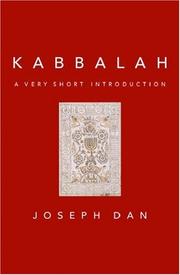| Listing 1 - 10 of 158 | << page >> |
Sort by
|
Book
Year: 1964 Publisher: Paris : Presses universitaires de France,
Abstract | Keywords | Export | Availability | Bookmark
 Loading...
Loading...Choose an application
- Reference Manager
- EndNote
- RefWorks (Direct export to RefWorks)
Book
ISBN: 311059997X 3110600854 3110598779 9783110599978 9783110598773 Year: 2020 Publisher: De Gruyter
Abstract | Keywords | Export | Availability | Bookmark
 Loading...
Loading...Choose an application
- Reference Manager
- EndNote
- RefWorks (Direct export to RefWorks)
The book focuses on Abraham Abulafia's esoteric thought in relation to Maimonides, Maimonideans, and Islamic thought in the line of Leo Strauss' theory of the history of philosophy. The book surveys Abulafia's sources and concentrates on the esoteric meaning on the famous parable of the three rings, as well as Abulafia's universalistic understanding of the nature of the Bible, the Hebrew language, the people of Israel or the Sinatic revelation. This book focuses on Abraham Abulafia's esoteric thought in relation to Maimonides, Maimonideans, and Islamic thought in the line of Leo Strauss' theory of the history of philosophy. A survey of Abulafia's sources leads into an analysis of the esoteric meaning on the famous parable of the three rings, considering also the possible connection between this parable, which Abdulafia inserted into a book dedicated to his student, the 13th century rabbi Nathan the wise, and the Lessing's Play "Nathan the Wise." The book also examines Abulafia's universalistic understanding of the nature of the Bible, the Hebrew language, and the people of Israel (or the Sinaic revelation). The universal aspects of Abulafia’s thought have been put in relief against the more widespread Kabbalistic views which are predominantly particularistic. A number of texts have also been identified here for the first time as authored by Abulafia.
Book
ISBN: 9020201395 Year: 2001 Publisher: Deventer Uitgeverij Ankh-Hermes BV
Abstract | Keywords | Export | Availability | Bookmark
 Loading...
Loading...Choose an application
- Reference Manager
- EndNote
- RefWorks (Direct export to RefWorks)
Klassieke Kabbalah --- Kabbalah-onderricht --- Toledo-traditie --- Cordovero-traditie --- Levensboom --- Jacobsladder --- kosmogenie --- de Lijn van Licht --- Sefiroth --- Kabbalah-groepen --- Z'ev ben Shimon Halevi --- the Kabbalah Society

ISBN: 9780195300345 9780195327052 0195300343 Year: 2007 Publisher: Oxford Oxford University Press
Abstract | Keywords | Export | Availability | Bookmark
 Loading...
Loading...Choose an application
- Reference Manager
- EndNote
- RefWorks (Direct export to RefWorks)
Cabala --- 296*41 --- 296*41 Kabbala --- Kabbala --- Cabbala --- Jews --- Kábala --- Kabalah --- Kabbalah --- Qabalah --- Jewish literature --- Magic --- Mysticism --- Judaism --- Cabala. --- ancient Jewish mystisicm --- the Middle Ages --- the Medieval Kabbalah --- the Christian Kabbalah --- the Lurianic Kabbalah --- Hasidism --- the Sabbatian Messianic Movement
Book
ISBN: 3110684357 Year: 2021 Publisher: Berlin, Germany ; Boston, Massachusetts : Walter de Gruyter GmbH,
Abstract | Keywords | Export | Availability | Bookmark
 Loading...
Loading...Choose an application
- Reference Manager
- EndNote
- RefWorks (Direct export to RefWorks)
This volume is the first-ever collection of essays devoted to the Lurianic concept of tsimtsum. It contains eighteen studies in philosophy, theology, and intellectual history, which demonstrate the historical development of this notion and its evolving meaning: from the Hebrew Bible and the classical midrashic collections, through Kabbalah, Isaac Luria himself and his disciples, up to modernity (ranging from Spinoza, Böhme, Leibniz, Newton, Schelling, and Hegel to Scholem, Rosenzweig, Heidegger, Benjamin, Adorno, Horkheimer, Levinas, Jonas, Moltmann, and Derrida).
God (Judaism) --- Cabala --- History. --- Jewish philosophy. --- Kabbalah. --- Tsimtsum. --- modernity.

ISBN: 0882709127 Year: 2004 Publisher: Gainesville, Florida Bridge-Logos
Abstract | Keywords | Export | Availability | Bookmark
 Loading...
Loading...Choose an application
- Reference Manager
- EndNote
- RefWorks (Direct export to RefWorks)
occultism --- Satanism --- Christianity --- Wicca --- witchcraft --- witchcraft --- Goth --- Kabbalah --- vampirism
Book
ISBN: 2130451942 Year: 1998 Volume: 1105 Publisher: Paris PUF
Abstract | Keywords | Export | Availability | Bookmark
 Loading...
Loading...Choose an application
- Reference Manager
- EndNote
- RefWorks (Direct export to RefWorks)
Kabbalah --- Kabbalah. --- Cabala --- Kabbale --- la Kabbale --- la mystique juive --- l'Antiquité --- Geonim --- piétisme rhénan --- le mouvement kabbaliste --- 1150-1492 --- la première Kabbale --- Safed
Book
Year: 2018 Publisher: Durbanville AOSIS
Abstract | Keywords | Export | Availability | Bookmark
 Loading...
Loading...Choose an application
- Reference Manager
- EndNote
- RefWorks (Direct export to RefWorks)
Signposts to Silence provides a theoretical map of what it terms ‘metaphysical mysticism’: the search for the furthest, most inclusive horizon, the domain of silence, which underlies the religious and metaphysical urge of humankind in its finest forms. Tracing the footsteps of pioneers of this exploration, the investigation also documents a number of historical pilgrimages from a variety of cultural and religious backgrounds. Such mountaineers of the spirit, who created paths trodden by groups of followers over centuries and in some cases millennia, include Lao-Tzu and Chuang-Tzu, Siddhattha and Jesus, Sankara and Fa-tsang, Plato and Plotinus, Isaac Luria and Ibn Arabi, Aquinas and Hegel. Such figures, teachings and traditions (including the religions of ‘Judaism’, ‘Christianity’ and ‘Islam’; ‘Hinduism’, ‘Buddhism’ and ‘Taoism’) are understood as, at their most sublime, not final destiny and the end of the road, but signposts to a horizon of ultimate silence. The hermeneutical method employed in tracking such pioneers involves four steps:• sound historical-critical understanding of the context of the various traditions and figures• reconstruction of the subjective intentional structure of such persons and their teachings• design, by the author, of a theoretical map of the overall terrain of ‘metaphysical mysticism’, on which all such journeys of the spirit are to be located, while providing a theoretical context for understanding them tendentionally (i.e. taking the ultimate drift of their thinking essentially to transcend their subjective intentions)• drawing out, within the space available, some political (taken in a wide sense) implications from the above, such as religio-political stances as well as ecological and gender implications.Continuing the general direction of thought within what the author endorses to be the best in metaphysical mysticism in its historical manifestations, the book aims to contribute to peace amongst religions in the contemporary global cultural situation. It relativizes all claims to exclusive, absolute truth that might be proclaimed by any religious or metaphysical, mystical position, while providing space for not only tolerating, but also affirming the unique value and dignity of each. This orientation moves beyond the stances of enmity or indifference or syncretism or homogenisation of all, as well as that of mere friendly toleration. It investigates the seemingly daunting and inhospitable yet immensely significant Antarctica of the Spirit, the ‘meta’-space of silence behind the various forms of wordy ‘inter’-relationships. It affirms pars pro toto, totum pro parte, and pars pro parte: that each religious, mystical and metaphysical orientation in its relative singularity represents or contains the whole and derives value from that, and that each represents or contains every other. This homoversal solidarity stimulating individual uniqueness is different from and in fact implies criticism of the process of globalisation. While not taking part in a scientific argument as such, Signposts to Silence aims at promoting an understanding of science and metaphysical mysticism as mutual context for each other, and it listens to a number of voices from the domain of science that understand this.
Religion: general --- Absolute horizon --- Cosmos --- Neoplatonism --- Plotinus, Gnosticism --- Hegel --- Kabbalah --- Maimonides --- Taoism --- Plato --- Sefirot --- Absolute horizon --- Cosmos --- Neoplatonism --- Plotinus, Gnosticism --- Hegel --- Kabbalah --- Maimonides --- Taoism --- Plato --- Sefirot
Book
Year: 2012 Publisher: punctum books
Abstract | Keywords | Export | Availability | Bookmark
 Loading...
Loading...Choose an application
- Reference Manager
- EndNote
- RefWorks (Direct export to RefWorks)
"It is time that we turn to the divine Other outside of correlationism, to discover again its nature and to witness its truth as creator and sustainer of worlds . . . Only on the basis of divine creation can the radical contingency of the world and its openness to its own miraculous nature be fully thought." What should philosophical theology look like after the critique of Onto-theo-logy, after Phenomenology, and in the age of Speculative Realism? What does Kabbalah have to say to Philosophy? Since Kant and especially since Husserl, philosophy has only permitted itself to speak about how one relates to God in terms of the intentionality of consciousness and not of how God is in himself. This meant that one could only ever speak to God as an addressed and yearned-for holy Thou, but not to God as infinite creator of all. In this book-length essay, the author argues that reality itself is made up of the Holy Name of God. Drawing upon the set-theoretical ontology of Alain Badiou, the computational theory of Stephen Wolfram, the physics of Frank Tipler, the psychoanalytical theory of Jacques Lacan, and the genius of Georg Cantor, the author works to demonstrate that the universe is a computer processing the divine Name and that all existence is made of information (the bit). As a result of this ontic pan-computationalism, it is shown that the future resurrection of the dead can take place and how it may in fact occur. Along the way, the book also offers compelling critiques of several significant theories of reality, including the phenomenological theologies of Emmanuel Levinas and Jean-Luc Marion, Process Theology, and Object-Oriented Ontology. Reality in the Name of God explores how the concepts of Jewish mysticism can be articulated and deployed as philosophical theses within current metaphysical debates. It provides a new and dynamic Structural Realist ontology of information. Ultimately, the book aims to deal a death blow to the restriction of philosophy and theology in relation to elaborations of a how a believer relates to a God outside the mind and to return thought to a direct encounter with the divine nature of reality itself and its creator.
Philosophical theology. --- God (Judaism) --- Ontology. --- Cabala. --- kabbalah --- speculative realism --- theology --- set theory --- ontology --- Jewish mysticism --- Name. --- kabbalah --- speculative realism --- theology --- set theory --- ontology --- Jewish mysticism
Book
ISBN: 0827612885 0827612869 9780827612860 9780827612884 9780827612563 0827612567 9780827612877 0827612877 Year: 2016 Publisher: Philadelphia Lincoln
Abstract | Keywords | Export | Availability | Bookmark
 Loading...
Loading...Choose an application
- Reference Manager
- EndNote
- RefWorks (Direct export to RefWorks)
| Listing 1 - 10 of 158 | << page >> |
Sort by
|

 Search
Search Feedback
Feedback About UniCat
About UniCat  Help
Help News
News